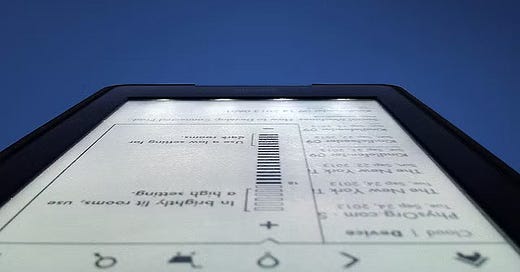Does a front light cause eye strain and disrupt the circadian rhythm?
Despite being an improvement over backlights, warmer front lights still contribute to eye strain and circadian rhythm disruption.
One of the major selling points of E Ink technology is its non-emissive nature. A front light can be added but does not affect E Ink screens' reflectivity in brighter conditions. Barnes & Noble was one of the early adopters of using a frontlight with the introduction of Nook Simple Touch with GlowLight in 2012. The front light became a standard feature with most e-readers after the release of Kindle Paperwhite in October 2012.
This raises the question: Does a front light generate eye strain? E Ink and vendors using E Ink technology claim that a frontlight is fundamentally different from a backlit LCD screen, as the light does not emit the light directly into the user’s eyes. According to Onyx BOOX, the front light seeks to illuminate the screen by aiming the light sources inwards to the screen to light up the display:
On the contrary, The front light is placed in front of the E Ink screen and under the bezel. The little small bulbs aim their light sources inwards to the screen and light up the display. So you can see the screen because it becomes brighter. As the front lights are placed around a screen, it’s challenging to make a larger screen illuminated evenly.
A study indicates that front lights are slower at causing eye strain. The study is a lab-based experiment that uses retinal cells to measure the effect of various devices on the mitochondria of the cells.
A front light is not a sure safe alternative to a back light. E Ink implicitly acknowledges the issue when it claims Kaleido 3 uses a new front light technology to reduce blue light reflected off the surface of the display:
E Ink Kaleido 3 is using E Ink’s Print Color ePaper technology, where a color filter array (CFA) is used in conjunction with E Ink’s Carta black and white ink film, creating a full color device for a more fully realized eBook shopping and reading experience. In addition to improved color performance, Kaleido 3 uses E Ink ComfortGaze™, a new front light technology designed by E Ink's Front Light Team. ComfortGaze has been engineered to reduce the amount of blue light reflected off the surface of the display, providing further comfort while reading. ComfortGaze has been engineered to reduce the amount of blue light reflected off the surface of the display, providing further comfort while reading with reduced Blue Light Ratio (BLR) and Blue Light Toxicity Factor (BLTF) by up to 60 percent and 24 percent respectively compared to the previous generation of front light design.
The reduction of blue light is a significant issue with Kaleido 3, as the front light must be turned on most of the time due to the dim screen caused by the colour filter array. On the other hand, as a black-and-white E Ink screen is not dependent on a front light, it becomes a utility turned on when needed.
As a front light is relatively better than a back light, the question is whether the blue light it emits is the culprit of many ills (a common marketing claim). In the technology industry, a trend emphasises low blue light certifications to promote users’ eye health.
Research shows that blue light affects the biological clock and is disruptive at night. However, while blue light is more disruptive, light of any kind interferes with a person’s circadian rhythm:
While light of any kind can suppress the secretion of melatonin, blue light at night does so more powerfully. Harvard researchers and their colleagues compared the effects of 6.5 hours of exposure to blue light to green light of comparable brightness. The blue light suppressed melatonin for about twice as long as the green light and shifted circadian rhythms by twice as much (3 hours vs. 1.5 hours).
In its marketing, Daylight Computer Company emphasises the negatives of blue light exposure, making the issue almost the raison d'etre of its DC-1 tablet. Due to the instability of viewing angles of DC-1’s LCD-based display, an inbuilt light source is needed for indoor usage. Daylight advertises the backlight as ‘blue light-free’. Yet, while better than blue light exposure, the amber glow light of DC-1 does not remedy eye strain or the shifting of circadian rhythms.
Concluding thoughts
Two points can be made on the issue of front light and blue light exposure:
While a front light is slower at causing eye strain than a back light, its use for hours is still problematic. A front light can be considered a utility in dimmer lighting, but comfortable reading is better with no light source.
Exposure to blue light is worse than others in suppressing melatonin and shifting the circadian rhythm. Kobo was the first to address the issue, releasing Aura One with a warmer light configuration in September 2016. Nevertheless, any reading light potentially disrupts the circadian rhythm.





Thanks for writing on this subject as we get a lot of half truths and trickery. It's important to know what the trade-offs are when buying screen tech.